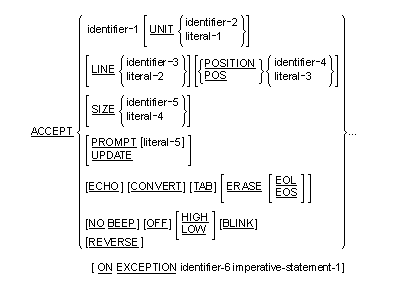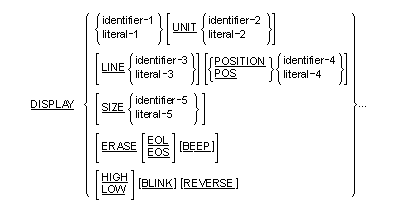

 | Microsoft COBOL V1.0 and V2.0 Syntax Support | Data General Interactive COBOL V1.3 Syntax Support |  |
The syntax listed in this chapter is accepted by your COBOL system purely for compatibility with version 2.0 of Ryan McFarland COBOL. Many features found in Ryan McFarland COBOL exist already in this COBOL implementation. These are documented in your Language Reference. Some of the compatibility syntax listed in this chapter is identical to standard COBOL syntax, but behaves differently if you set the RM Compiler directive when you submit your source code to your COBOL system. See the RM/COBOL Language Reference Manual version 2.0 for a full description of the Ryan McFarland syntax.
The following format of the ASSIGN clause is supported:

The following format of the ORGANIZATION clause is supported:

However, if you specify the RM"ANSI" Compiler directive when you submit your source code to your COBOL system, this clause is treated as equivalent to ORGANIZATION IS LINE SEQUENTIAL.
However, if you specify the RM"ANSI" Compiler directive when you submit your source code to your COBOL system, then ORGANIZATION IS SEQUENTIAL is assumed.
The following clause is accepted in an FD entry:

In the Data Division, nonnumeric literals up to 2047 characters long are allowed if you set the RM Compiler directive when you submit your source code to your COBOL system.
The syntax:

is assumed in the SPECIAL-NAMES paragraph if you set the RM Compiler directive when you submit your source code to your COBOL system. However, if you specify the RM"ANSI" Compiler directive when you submit your source code to your COBOL system, this phrase is not assumed.
The following format of the USAGE clause is supported:

Literals can be used as parameters to CALL statements.
The EXIT PROGRAM statement closes all files that the subprogram being exited has open, if you set the RM Compiler directive when you submit your source code to your COBOL system.
However, if you specify the RM"ANSI" Compiler directive, the EXIT PROGRAM statement does not do this.
If you set the RM Compiler directive when you submit your source code to your COBOL system, table subscripts are not bound checked.
Two bytes are allocated to index data items, instead of the normal four, if you set the RM Compiler directive when you submit your source code to your COBOL system.
The following format of the ACCEPT statement is supported:

The following format of the DISPLAY statement is supported:

Alphanumeric values can be stored in numeric data items, but will be right
justified (as is normal with a numeric receiving item) and space-filled on
the left. For example, if "AB" is moved to an item
decribed as PIC 9(5), the value stored will be " AB".
The RM/COBOL language permits OPEN and CLOSE statements to be specified with NO REWIND on a sequential file. In the standard COBOL language, such statements are treated as documentary only.
Your COBOL system normally uses a stack for handling PERFORM statements, while the RM/COBOL system associates a return address with a specific procedure name. As a result, under the RM/COBOL system all end-points of PERFORM statements are active until they are used, whereas under your COBOL system only the end-point of the innermost current PERFORM statement is active at any one time.
However, if the PERFORM-TYPE"RM" Compiler directive is set, your COBOL system will handle PERFORM statements in the way RM/COBOL does.
Programs can contain procedure-names that are the same as data-names.
The REWRITE statement can be used on sequential files, providing the new record is the same length as the original.
The following format of the STOP RUN statement is supported:

COBOL I-O status codes are mapped onto their RM equivalents if you specify the RM Compiler directive when you submit your source files to your COBOL system.
If you specify the RM Compiler directive when you submit your source files to your COBOL system and a record is found to be locked, the following happens:
Copyright © 2000 MERANT International Limited. All rights reserved.
This document and the proprietary marks and names
used herein are protected by international law.
 | Microsoft COBOL V1.0 and V2.0 Syntax Support | Data General Interactive COBOL V1.3 Syntax Support |  |